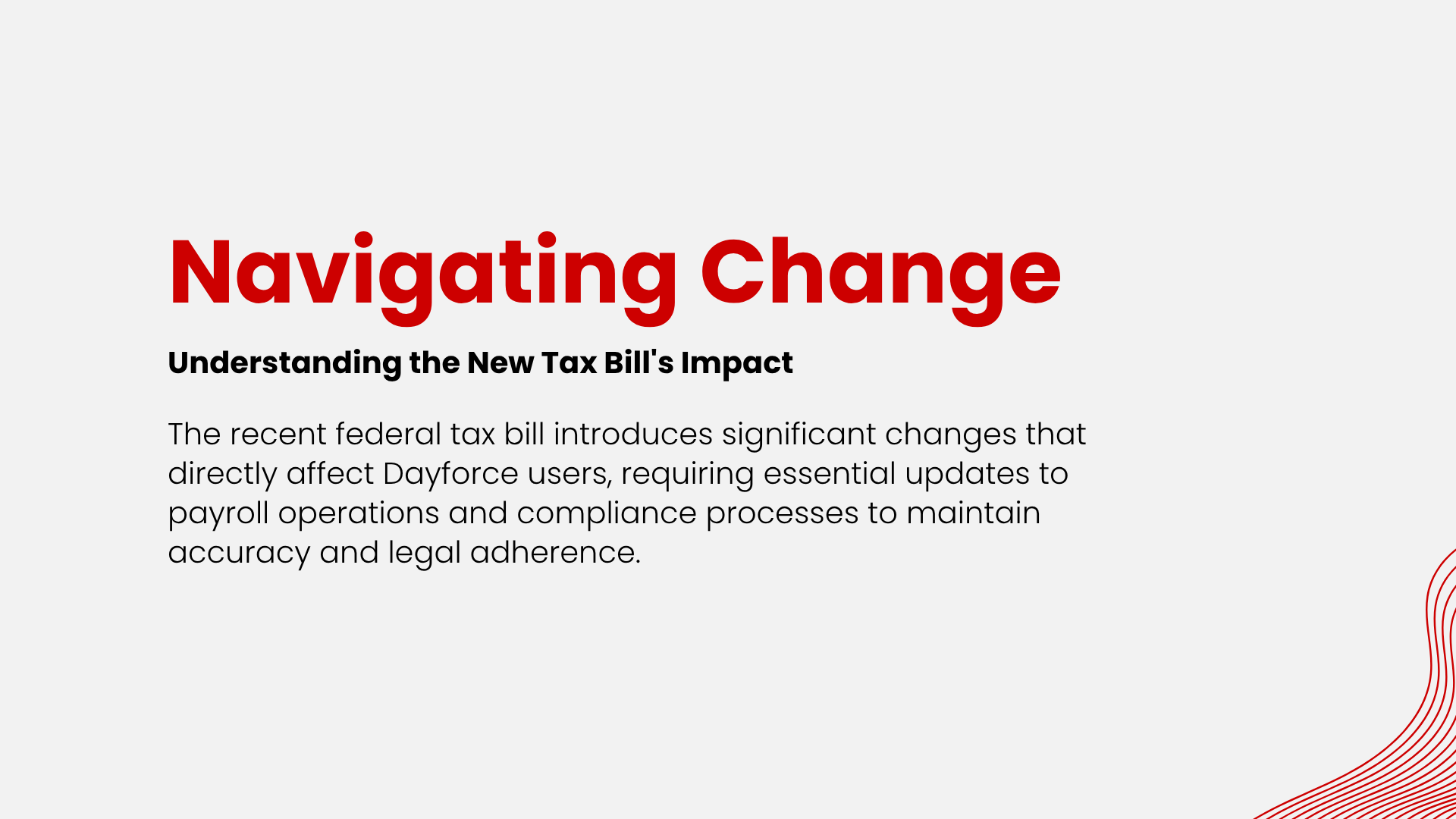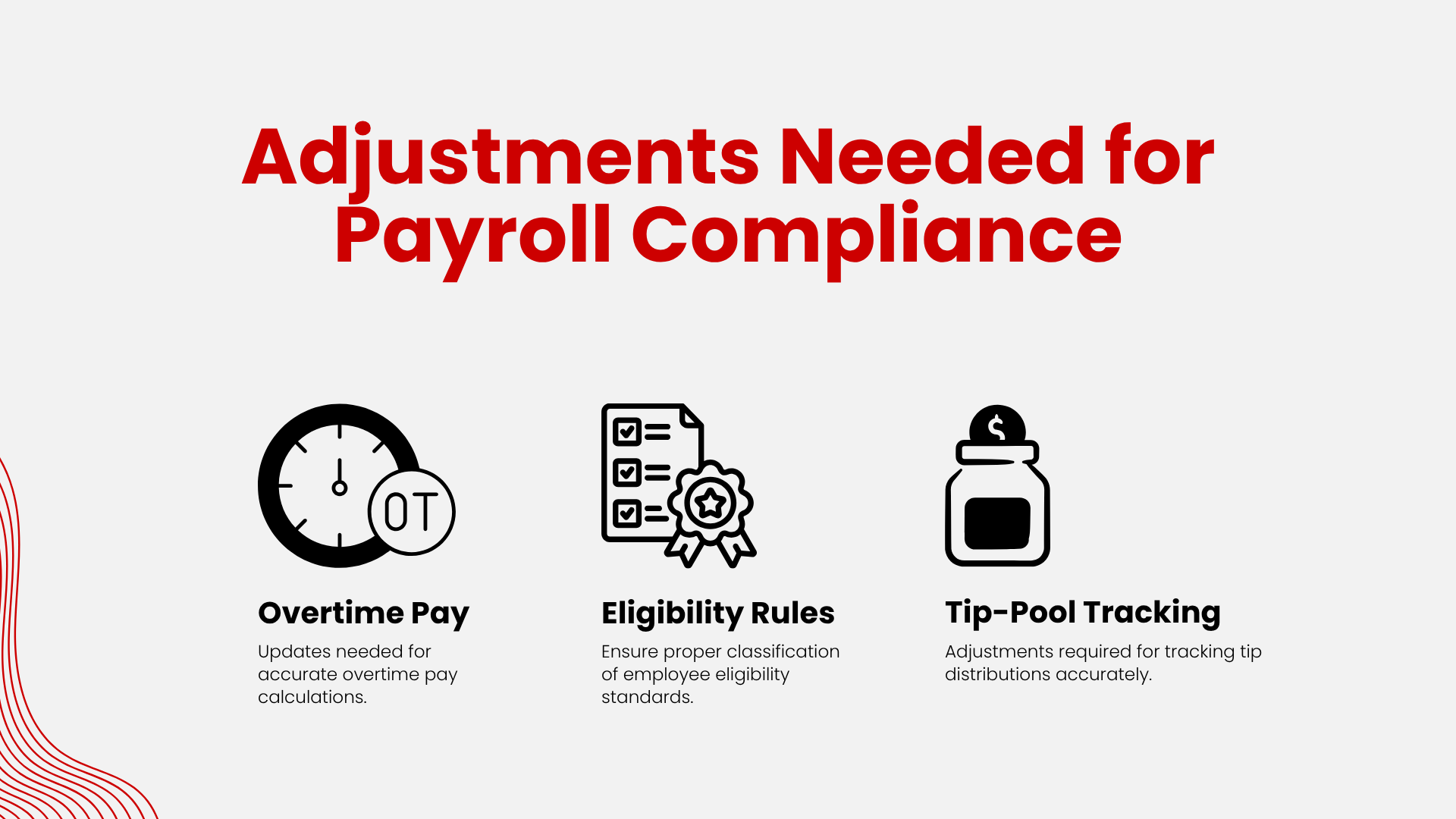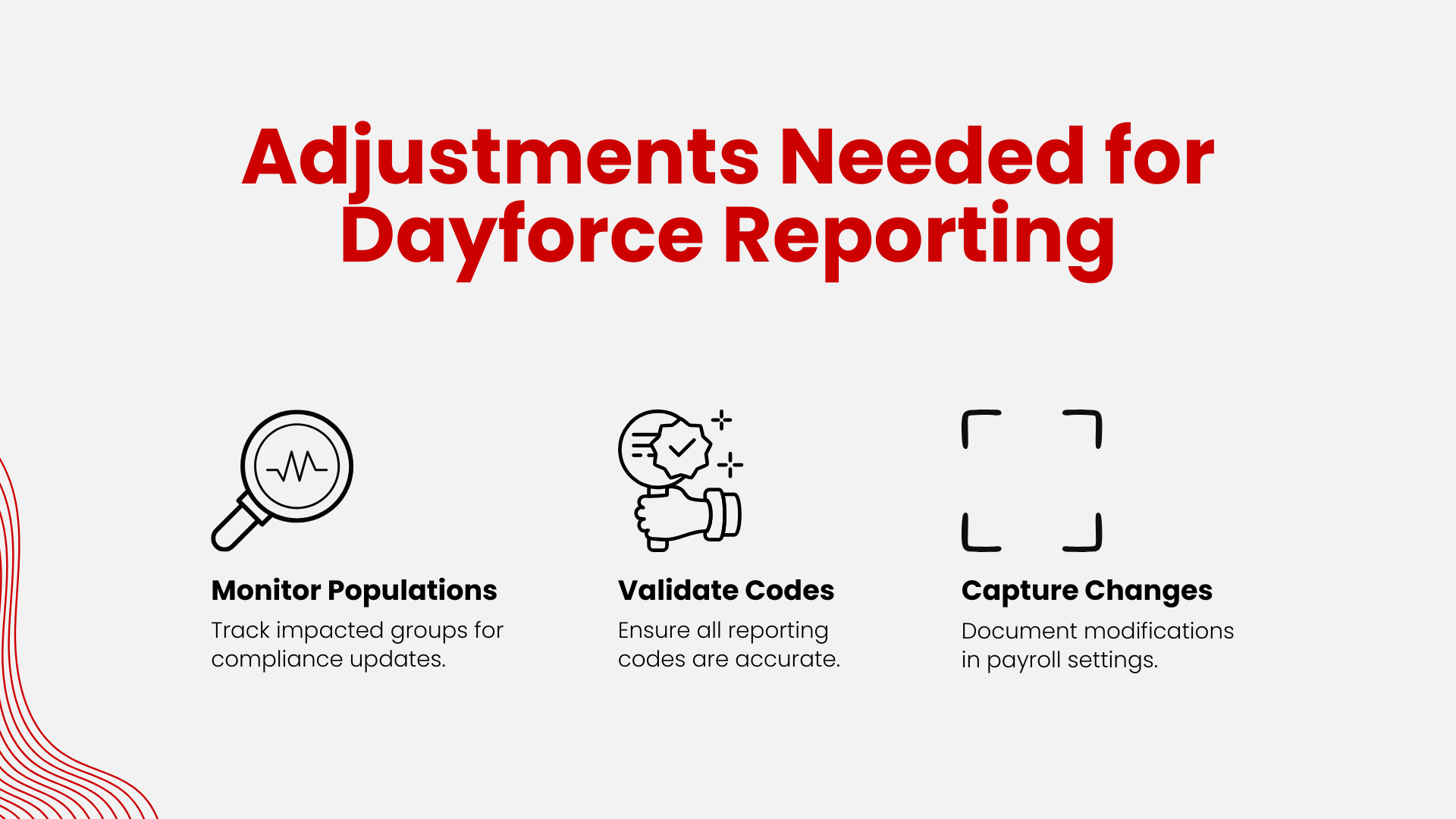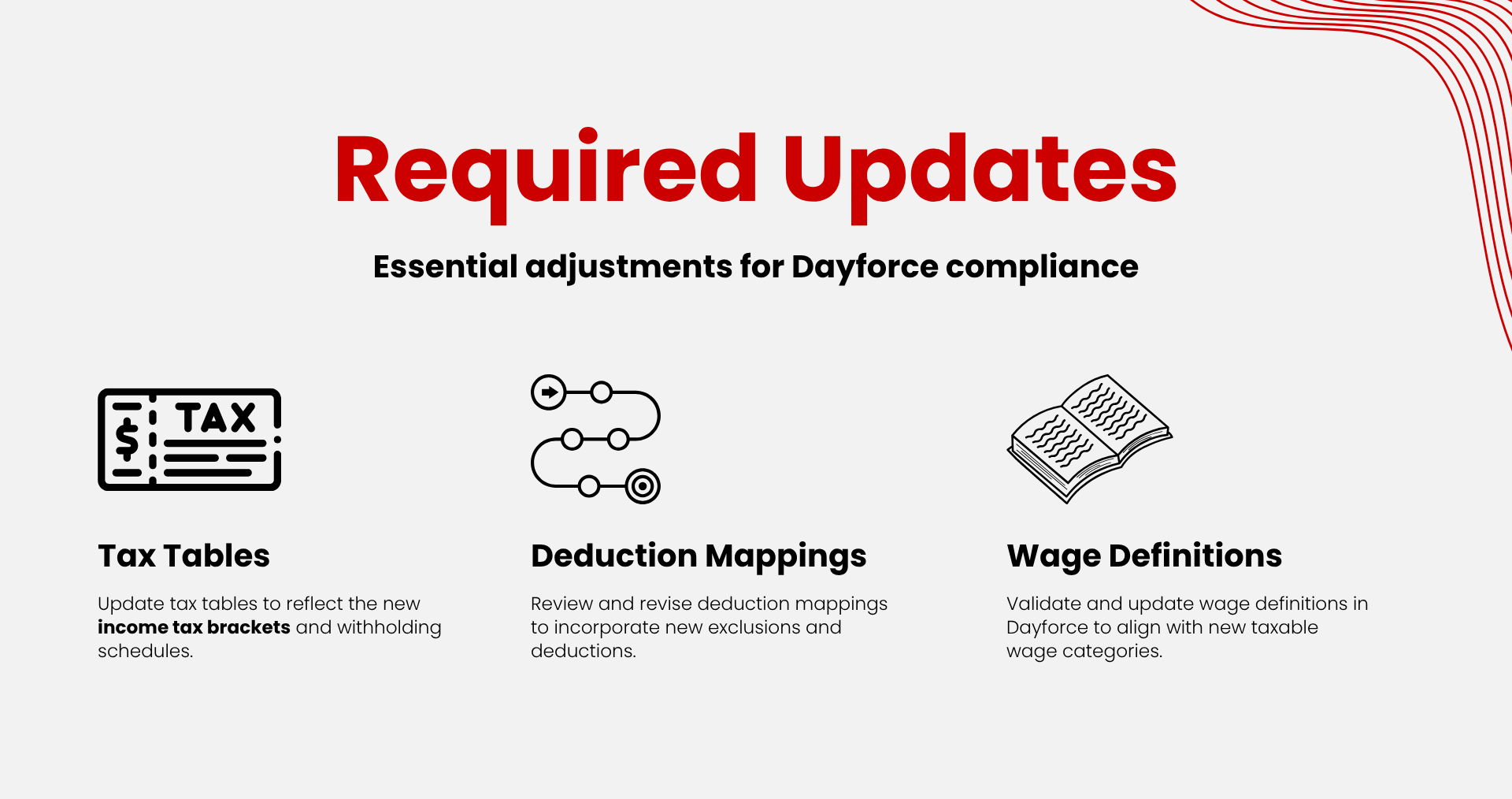What the New US Tax Bill Means for Dayforce Users
blog/what-the-new-us-tax-bill-means-for-dayforce-users
2025-11-05 | Dayforce Articles and Insights
Table of Contents
(1) Summary of New Tax Bill
(2) How Does the New Tax Bill Affect Dayforce Customers
Payroll / Tax Witholding
Compensation & Pay Codes
Benefits / Total Rewards
Reporting & Analytics
(3) Detailed Breakdown of the 2025 U.S. Tax Bill
(4) What Employers Should Do Now
(5) How Red Pill Labs Can Support Your Organization Through the Transition Period
The latest federal tax bill from the United States has major implications for employers nationwide, signaling an upcoming shift in payroll processes, compliance standards, and reporting requirements.
For Dayforce users, this means key changes to daily payroll operations and vital changes to the current configuration of your Dayforce platform.
Below, we outline what’s changing, which parts of your Dayforce setup will be affected, and what steps employers should take to stay compliant and efficient as these updates roll out.
Summary of New Tax Bill
The new legislation extends individual income tax brackets under the Tax Cuts and Jobs Act, increases the State and Local Tax (SALT) deduction cap from $10,000 to $40,000, and introduces deductions for overtime pay, tips, and qualifying car loan interest.
While these updates may seem minor on paper, they alter taxable wage definitions and deduction categories—affecting how Dayforce calculates net pay, manages compliance, and processes reporting.
Even small adjustments to taxable wages or deduction logic can create downstream impacts on pay accuracy, year-end filings, and employee communications.
How Does the New Tax Bill Impact Dayforce Customers?
Each of the following modules requires review and configuration updates once the law takes effect.
The biggest challenges our Dayforce Payroll Experts expects for US-based Dayforce organizations are:
Reconfiguring payroll and tax-withholding setups to align with new exclusions for overtime, tips, and adjusted tax brackets.
Ensuring pay-code accuracy and eligibility rules across complex employee groups (e.g., tipped, overtime, multi-state).
Maintaining compliance and audit readiness through year-end as new taxable wage definitions and reporting requirements take effect
Payroll / Tax Withholding
This module is responsible for managing tax-withholding tables, deduction types, and taxable wage definitions.
With the new federal tax bill, organizations must review and update these elements to reflect new exclusions for overtime pay, tips, and other qualifying categories.
It is also essential to confirm that system mappings and schedules align with the revised tax brackets.
For example:
If new deductions or exclusions are introduced, payroll setup must reflect them so that net pay and tax withholding remain accurate.
When tax brackets, standard deductions, or taxable wage definitions change, Dayforce tax-code mapping and withholding schedules will require adjustment.
Employees in tipped or high-overtime roles must have proper documentation and pay-code classification to ensure the correct tax treatment applies.
Actions Required:
Review and update all tax tables and deduction mappings.
Validate taxable wage definitions against new IRS guidance.
Test payroll runs for employees with tips or overtime to confirm accurate withholding.
Audit all pay-code classifications for compliance with the new tax categories.
Compensation & Pay Codes
The changes may introduce new categories of compensation or deduction.
That means your pay-code structure, overtime definitions, tip-pool tracking (if applicable) and classification of employees (eligible vs non-eligible for new exclusions) must be reviewed.
This module ensures that strategy (how you pay people) aligns with configuration (how the system recognizes pay).
For example:
The overtime pay deduction means pay codes, eligibility rules, and overtime multipliers must be reassessed so employees receive correct net pay and tax treatment.
Action(s) Required:
Review and update all pay codes to reflect new deductions or exclusions.
Verify eligibility rules for overtime, tipped roles, and other impacted employee groups.
Test pay runs to ensure correct calculations for all affected employees.
Audit historical pay code usage to identify inconsistencies or errors that could impact compliance.
Benefits / Total Rewards Module
Changes to tax law can affect the value of benefits, the employee’s take-home pay, and how you communicate total compensation.
For example:
If the standard deduction rises, employees might see different net take-home and may view benefit offerings differently.
If there are special new deductions for certain groups (e.g., tipped workers, older workers) that affect taxable income, your benefit-modelling needs to reflect that shift.
The benefit enrolment/configuration needs to ensure that any tax-advantaged benefits remain compliant and flagged correctly.
Action(s) Required:
Review benefit configurations to account for changes in taxable income or standard deductions.
Ensure tax-advantaged benefits are correctly flagged in Dayforce.
Model total compensation scenarios to communicate potential take-home pay changes to employees.
Update employee communications and benefit statements to reflect new net pay calculations.
Reporting & Analytics Module
With new tax law changes, your reporting needs shift: you may need to monitor impacted populations (tipped workers, heavy overtime workers, high SALT states) and provide analytics on net pay changes, deduction changes, payroll cost impact, etc.
Ensuring your report library, dashboards, and audit logs reflect the new categories is vital.
Action(s) Required:
Create dashboards and reports to monitor impacted populations, including tipped, overtime, and high-SALT employees.
Validate that all reporting codes reflect new deductions and exclusions.
Ensure audit logs capture all changes in payroll, pay codes, and deductions.
Test reporting outputs to confirm accuracy before year-end.
Year-End / Tax Filing Module
As the tax law changes take effect, your year-end processes become more critical.
The system must ensure correct classification of wages, deductions, exclusions for 2025 tax year (or whichever year the law starts), proper reporting codes, interface with tax authorities and audit readiness.
By proactively auditing and optimizing these modules, you mitigate risk, ensure compliance and improve payroll/HR operations in Dayforce.
Action(s) Required:
Review and update year-end payroll processes for compliance with 2025 tax provisions.
Validate proper classification of wages, deductions, and exclusions in preparation for 2026 filings.
Confirm interfaces with tax authorities are accurate and tested.
Maintain detailed documentation of changes for audit readiness.
Detailed Breakdown of the 2025 U.S. Tax Bill
Below is a closer look at the core provisions of the 2025 tax-and-spending package:
Standard Deduction & Tax Brackets
What it is: Extends lower individual income tax rates from the earlier Tax Cuts and Jobs Act and increases the standard deduction.
For 2025, single filers may see an increase of about US $750, and married joint filers around US $1,500.
Why it matters: Payroll systems must adjust withholding assumptions and recalculate tables for the new standard deduction amounts.
SALT Deduction Cap
What it is: Raises the SALT deduction limit from US $10,000 to US $40,000 for 2025.
Why it matters: Employees in high-tax states may experience higher itemized deductions, affecting their net pay and benefit expectations.
Dayforce reporting and total compensation statements may need updates to reflect these shifts.
New Exclusions and Deductions
What it is: Introduces tax relief for tipped workers (exclusions up to US $25,000) and overtime pay (deductions up to US $12,500), along with new deductions for seniors aged 65+ (up to US $6,000 through 2028).
Why it matters: Payroll and deduction classification modules in Dayforce must be updated to recognize these new categories and apply the correct tax treatment.
Business & International Tax Changes
What it is: Extends or makes permanent several business provisions, including bonus depreciation and pass-through deductions, and modifies global tax frameworks (GILTI, FDII, BEAT).
Why it matters: Employers managing international payrolls or cross-border employees may need to verify contractor classification and payroll compliance inside Dayforce.
Effective Dates & Transition
What it is: The bill became public law on July 4, 2025, with most provisions effective for the 2025 tax year.
Payroll cycles beginning January 2026 will reflect the new rules, with some measures expiring in 2028.
Why it matters: Employers must ensure payroll configuration and year-end 2025 reporting align with the updated provisions to avoid compliance issues in early 2026.
What Employers Should Do Now
To prepare for the transition, employers should begin configuration reviews and testing as soon as possible.
Audit Payroll Setup: Validate tax tables, deduction types, and pay codes against new federal rules.
Model Compensation Impact: Simulate take-home pay shifts for tipped, overtime, and high-tax-state employees.
Update Reporting Frameworks: Build dashboards and filters in Dayforce to track affected groups and monitor financial impact.
Document for Audit Readiness: Maintain accurate mapping between pay codes, deductions, and taxable income definitions.
Employers in hospitality, retail, healthcare, and other overtime and/or tip-heavy industries will face the largest configuration changes and should begin review early.
Employers must align their Dayforce systems so that the payroll year-end 2025 and beginning 2026 processes are compliant.
How Red Pill Labs Can Support Your Organization Through the Transition Period
The new tax bill requires US based organizations using Dayforce to review and optimize their current configuration to remain compliant.
At Red Pill Labs, we help organizations translate legislative complexity into clean, reliable Dayforce performance, making sure your system not only meets new legal requirements, but continues to run efficiently and accurately as those requirements change.
In addition to our year-end services (i.e., hypercare, training, etc.), our specialty in Dayforce audits and optimizations helps you identify every risk and consideration within your HCM setup and ensures your configuration and overall strategy work effectively for your team.
From payroll recalibration to employee communication and compliance alignment, we help you navigate the 2025 tax transition with confidence.
Have a Project? Get a Quote.
Still browsing? Check out our extensive Dayforce Services below.
Tailored Dayforce Support
Year End Support (hyper-care, regulatory compliance, payroll adjustments, and more)
Dayforce Training (custom learning plans & role-based learning)
On Demand Support (monthly hours of quick troubleshooting, advisory, and technical support)







